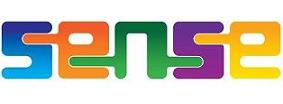Sense (programming)
 | |
| Paradigm | object-oriented, educational, event-driven |
|---|---|
| Designed by | The Open University |
| Developer | The Open University |
| First appeared | 2008 |
| Stable release | Build 136
|
| Typing discipline | Dynamic |
| Implementation language | Squeak |
| OS | Windows, OS X, Linux[1] |
| Filename extensions | .sb[2] |
| Website | sense |
| Major implementations | |
| Scratch | |
| Influenced by | |
| Scratch | |
Sense is an educational programming environment created by The Open University (OU) in the United Kingdom .[3][4] It uses a drag-and-drop programming environment designed to teach students the fundamentals of computer programming, using different shape and colour "blocks" selected from a palette of available commands, meaning that the student needs no prior experience of programming nor need to learn a syntax. It is based on the Scratch programming language developed by the MIT Media Lab,[5] and uses .sb files[6] like Scratch but the two pieces of software cannot use each other's files.[7]
The Sense programming environment is designed to work in conjunction with the SenseBoard, a specialised piece of hardware which connects to a user's computer via a USB connection.[8][9] The SenseBoard has different input types such as sensors for infrared, light, sound (microphone), and temperature (thermometer), and outputs such as a motor and light emitting diodes (LEDs).[10]
Sense and the SenseBoard are primarily used as part of the OU's My Digital Life (TU100) module,[11] but is also used to a lesser degree on other modules. Sense was trialed in London schools in late 2012.
References
- ↑ "OLCreate: TU100_1.0 Sense installation". http://labspace.open.ac.uk/mod/oucontent/view.php?id=439696.
- ↑ "OLCreate: TU100_1.0 FAQ pages". http://labspace.open.ac.uk/mod/oucontent/view.php?id=454004§ion=2.
- ↑ Flaherty, Adam (14 June 2011). "Hands-on Learning with The SenseBoard Ubiquitous Computing Device". MAKE Blog. http://blog.makezine.com/2011/06/14/hands-on-learning-with-the-senseboard-ubiquitous-computing-device/.
- ↑ Geere, Duncan (14 June 2011). "Technology Open University offers up hardware to coding students". Wired.co.uk. https://www.wired.co.uk/news/archive/2011-06/14/open-university-coding-hardware.
- ↑ "Open University offers up hardware to coding students (Wired UK)". https://www.wired.co.uk/news/archive/2011-06/14/open-university-coding-hardware.
- ↑ "OLCreate: TU100_1.0 FAQ pages". http://labspace.open.ac.uk/mod/oucontent/view.php?id=454004§ion=2.
- ↑ "OLCreate: TU100_1.0 FAQ pages". http://labspace.open.ac.uk/mod/oucontent/view.php?id=454004§ion=2.
- ↑ "Open University offers up hardware to coding students (Wired UK)". https://www.wired.co.uk/news/archive/2011-06/14/open-university-coding-hardware.
- ↑ "OLCreate: TU100_1.0 Sense installation". http://labspace.open.ac.uk/mod/oucontent/view.php?id=439696§ion=3.
- ↑ "OLCreate: TU100_1.0 Sense installation". http://labspace.open.ac.uk/mod/oucontent/view.php?id=439696.
- ↑ "The Open University | Courses and Qualifications". http://www3.open.ac.uk/study/undergraduate/course/tu100.htm.
External links
 |

